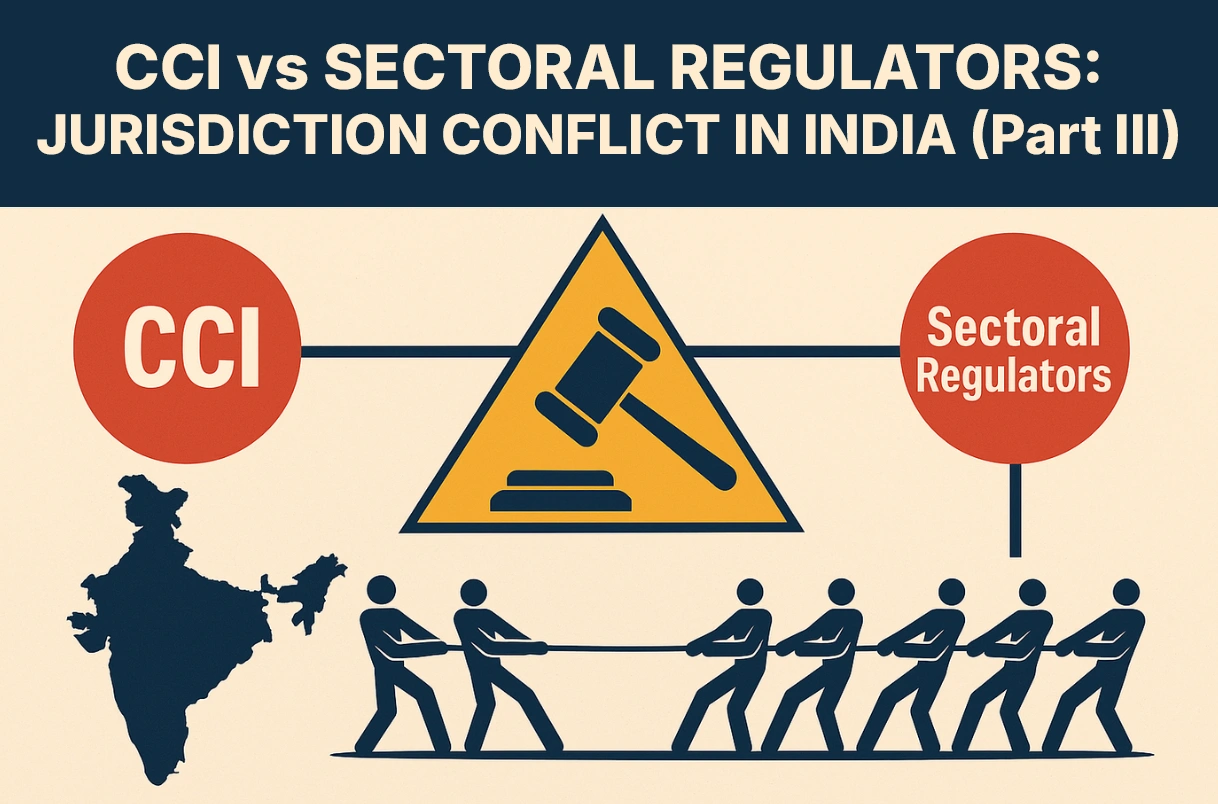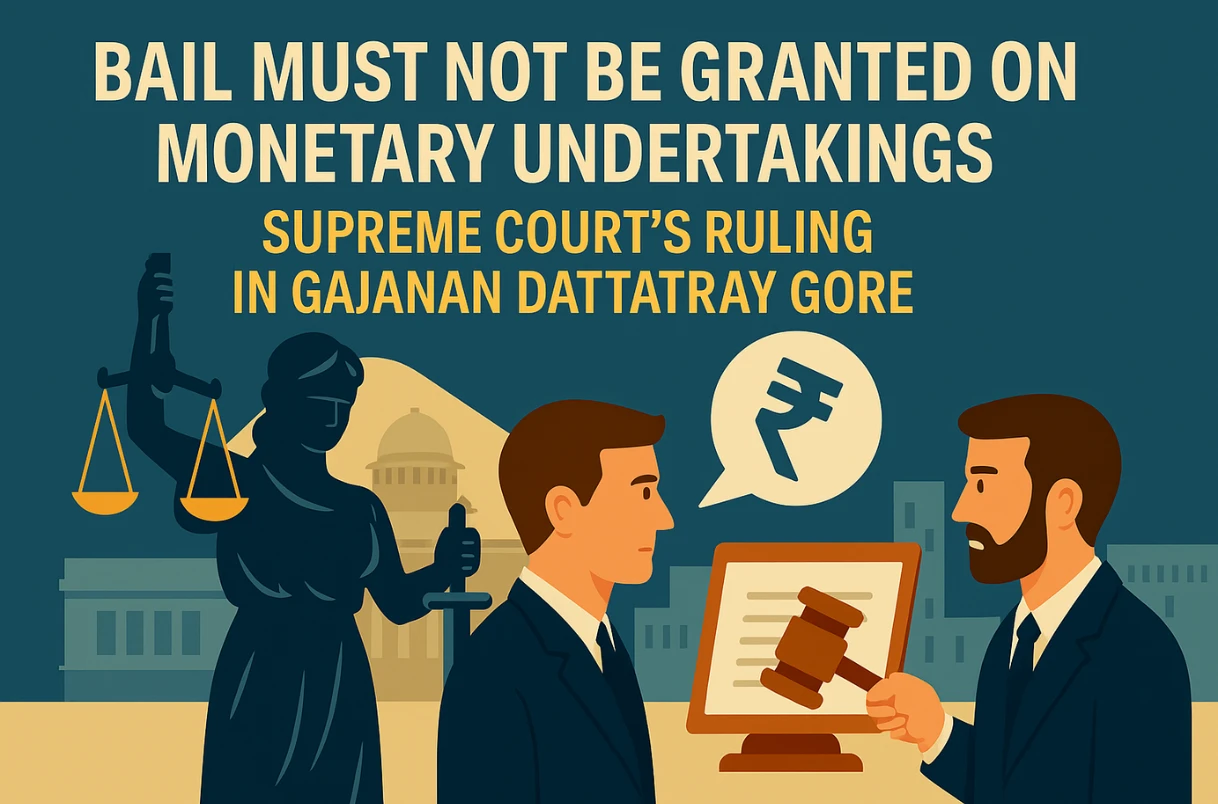Jurisdictional Conflict in Competition Law: CCI vs Sectoral Regulators in India (Part 3)

By – Sakya Singha Chaudhuri and Asmita Narula
Table of Contents
Introduction
Over the last two weeks, we examined how the jurisdiction of the Competition Commission of India (CCI) intersects—and often clashes—with various sectoral regulators. In the first part, we focused on the CCI–TRAI conflict and the legal principles governing overlapping regulatory authority in the telecom sector. The second part extended the discussion to the Copyright Board, the Controller of Patents, and the Electricity Regulatory Commissions, where we analyzed judicial reasoning in matters involving intellectual property and sector-specific price controls.
In this final part, we expand the scope further. We examine jurisdictional conflicts in other regulated domains—such as aviation and professional self-regulatory bodies like the ICAI—and assess how international jurisdictions manage overlaps between competition authorities and sectoral regulators. The goal is to reflect on lessons that India might draw from global practices and identify the structural and legislative tools needed to bring greater coherence to the regulatory landscape.
Conflict with the Aviation Sector
Market Power in Airports and Airlines
Both airlines and airports across the world have been subject to investigation by competition authorities. Airports often enjoy a monopolistic position in terms of location, traffic, connectivity, and such factors. There are frequent joint ventures, tie-ups, mergers, acquisitions, and code-shares amongst airline companies that give rise to the possibility of anti-competitive conduct.
India has an Airport Economic Regulatory Authority (AERA) that is responsible for fixing the airport charges for major airports. However, price setting does not necessarily ensure fair conduct.
Airports often enjoy a dominant position given their typical setup and functioning, which allows them to manipulate or dictate terms for airport users, including airline companies.
The Cluj Airport Case: Abuse of Dominance in Europe
The European Court of Justice1 recently upheld the fine imposed on Cluj International Airport by the Romanian Competition Authority for refusing access to infrastructure needed to provide ground-handling services to Romanian Airport Services on a reference made to it. The Court of Justice held that even though the airport may be exempt under sectoral rules from the regulation of ground-handling services, that would not preclude the applicability of competition law for abusing a dominant position where a supplier of the ground-handling services has been refused access to the airport infrastructure.
The aviation sector in India is dominated by very few players in terms of national and international carriers. Thus, it is relatively easier to enter into anti-competitive agreements and hinder the entry of any new players.
Price-Fixing in French Antilles—The FCA’s Verdict
The French Competition Authority had initiated an investigation into anti-competitive agreements leading to a significant and simultaneous increase in ticket prices of Air Antilles and Air Caraïbes on the Fort-de-France/Pointe-à-Pitre route. The airlines have been fined for such anti-competitive arrangements.
The FCA found that Air Antilles and Air Caraïbes were involved in an exchange of prices and pricing conditions, and they also agreed to reduce their capacity through a joint fleet pooling program, where the flight hours, available seats, and frequency of flights had been reduced, allowing them to increase the ticket prices significantly.
GMR & Delhi Airport Case—CCI’s Current View
Recently, CCI has dismissed allegations of anti-competitive conduct by GMR Airports and Delhi Airport in the awarding of certain contracts. A complaint was filed against GMR Airports alleging that it was charging excessive fees for contracts related to parking and lounge services at the Delhi airport. The complaint was dismissed on the ground that the contracts for parking and lounge services were awarded through a competitive bidding process. However, there may be instances where service providers selected through bidding resort to anti-competitive practices, especially when awarded exclusive rights over airport infrastructure.
Conflict with the Institute of Chartered Accountants of India (ICAI) [Chartered Accountants Act, 1949]
ICAI’s Continuing Education Monopoly
A claim of abuse of dominant position was raised against ICAI in Institute of Chartered Accountants of India v. The Competition Commission of India and Ors.2, on the ground that ICAI, along with affiliates, is the only institute that can conduct the structured learning activities under the Continuing Professional Education (CPE) program, and no other body was affiliated/recognized for it.
The Delhi High Court upheld ICAI’s decision to conduct the CPE program being one taken as a regulator and not as a service provider. Such decisions do not operate in any market of trade or commerce and thus cannot be a subject matter of review by the CCI. The Court has made the following important observations:
Defining CCI’s Reach Over Statutory Bodies
- There are several statutory corporations and bodies constituted under legislative enactments that are charged with specific functions, some of which may also involve providing services. If such activities are not a part of its regulatory functions, it would be subject to CCI’s scrutiny; otherwise, it will not be subject to review by the CCI.
- CCI’s power is for regulating markets and does not extend to addressing any grievance regarding arbitrary action by any statutory authority. Its jurisdiction cannot extend to compel a statutory body to outsource its statutory functions/duties, even if they fall within the broad definition of ‘economic activity.’
- CCI has wide powers under the Competition Act; however, the scope of examination must be confined to those areas of economic activities that have a bearing on the market that engages entities involved in trade and commerce.
BCI and IRDAI—Parallel Exemptions
Similarly, institutes such as the Bar Council of India (BCI)3 and Insurance Regulatory and Development Authority of India (IRDAI)4, being regulatory in nature, are not amenable to CCI’s jurisdiction.
The jurisdictional conflict in other countries
UNCTAD’s Five Models of Regulatory Coordination
In a study conducted by the United Nations Conference on Trade and Development (UNCTAD)5 to examine the various frameworks under which competition authorities and sector regulators are coexisting, it was found that one of the reasons for the jurisdictional conflicts is the ambiguity in the law—whether sectoral regulation or competition law has precedence with respect to the competition issues.
There is no straitjacket formula for division of powers, responsibilities, and duties between the sectoral regulators and the competition authority. There are various factors that determine this, including social and economic parameters, legal system, regulations, etc. As per the UNCTAD study, the different approaches adopted to promote the coordination and cooperation between the competition authority concerned in a country and the sectoral regulators can be classified into 5 categories:
- Combining technical and economic regulation in a sector regulator and leaving competition enforcement exclusively for the competition authority.
- Combining technical and economic regulation in a sector regulator and giving it some or all competition law enforcement functions.
- Combining technical and economic regulation in a sector regulator and giving it competition law enforcement functions to be performed in coordination with the competition authority.
- Organizing technical regulation as a stand-alone function for the sector regulator and including the economic regulation within the competition authority.
- Relying solely on competition law enforcement by the competition authority.
Global Legal Approaches to Overlapping Jurisdiction
Different countries have adopted different approaches. Several countries have even adopted a combination of approaches. For instance,
United States—Sector-Based Mixed Model
The United States of America has adopted a combination of arrangements mentioned at point (a) and (b), and it differs from sector to sector. In some sectors, the competition authority has exclusive jurisdiction, and in some sectors, the competition authority and the sectoral regulator have concurrent jurisdiction.
United Kingdom—Concurrency with Procedural Clarity
The United Kingdom has adopted the arrangement mentioned at point (c). The competition authority and the sectoral regulators have concurrent jurisdiction. The Competition Act (Concurrency) Regulations provide the procedure to decide which authority is better suited to deal with a particular issue. The regulations also provide the procedure to resolve disputes that may arise.
South Africa—Agreements with Sectoral Regulators
South Africa has adopted the arrangement mentioned at point (c), i.e., concurrent jurisdiction. In sectors where the sector regulator has an explicit mandate over competition issues, the competition authority negotiates an agreement with it qua the exercise of jurisdiction over such issues. For instance, such agreements exist in the broadcasting sector and the electricity sector. Similarly, in Ireland, formal cooperation agreements were executed between the competition authority and the sectoral regulators.
Australia—Strong ACCC Centrality with Support
Australia has adopted a combination of the arrangements mentioned at points (d) and (e). In Australia, the Australian Competition and Consumer Commission (ACCC) has been established, inter alia, for antitrust regulation, which is favored over and above the sectoral regulators. However, the sectoral regulators, which have technical and economic regulatory responsibilities, are closely associated with the ACCC.
Canada—Regulated Conduct Doctrine
Canada has adopted a combination of the arrangements mentioned at points (b) and (c); however, there is no formal separation of jurisdiction of the competition authority and the sector regulators. One of the methods used to resolve a conflict is the ‘doctrine of regulated conduct,’ under which regulated entities are exempt from application of the competition law for conduct that is authorized under a valid law. Another method that has been used is signing a Memorandum of Understanding (MoU) setting out the roles of the agencies; however, there have been instances where even the MoU has been abandoned.
Brazil—Cooperation with Exclusive CCI Jurisdiction
Brazil has adopted the arrangement mentioned at point (a), i.e., exclusive jurisdiction of the competition authority in cooperation with the sectoral regulators.
New Zealand—Pure Competition Authority Jurisdiction
New Zealand has adopted the arrangement mentioned at point (e), i.e., exclusive jurisdiction of the competition authority and no role of the sectoral regulators.
European Union—Behavioral vs. Structural Split
In European Union (EU) member states, both the competition law and the sectoral law mandate the need for the competition authority and the sectoral regulators to confer with each other. The behavioral issues are left for the competition authority, and the structural issues are left for the sectoral regulator to ensure coordination and cooperation.
France and Argentina—Mandatory Consultations
In France and Argentina, the process of consultation between the competition authority and the sectoral regulators is mandatory. However, in Argentina, this applied to the competition authority and not the sectoral regulators.
Mexico—Authority-Driven Competition Triggers
Mexico has adopted a collaborative approach; i.e., the competition authority is responsible for determining whether the conditions for effective competition exist or they are sufficiently absent to justify the continued regulation of prices. In case conditions for effective competition do not exist, the administration of price control is entrusted to the sectoral regulators.
Conclusion
A straightjacket formula cannot be adopted by the courts of India to rule on the issue of jurisdictional conflict because of the varied provisions of different sectoral laws. There have been cases where the CCI and the sectoral regulator have concurrent jurisdiction as well, with the CCI focusing on competition issues and sectoral regulators handling technical, economic, and structural issues. There have been cases where the courts have concluded that, given the facts and circumstances, the sectoral regulators are better equipped to deal with the industry-specific issue, and cases where the exclusive jurisdiction of the CCI has been upheld.
Although Sections 21 and 21A of the Competition Act provide for reference to and by CCI vis-à-vis other authorities on competition issues, they are rarely invoked, and even if they are invoked, the conflict persists as the opinion rendered is not binding.
By way of the Competition (Amendment) Act 2023, a provision has been introduced that enables the CCI to enter into any memorandum of arrangement with any statutory authority or department of government for the purpose of discharging its duties or performing its functions under the Act. The said provisions can help resolve the jurisdictional conflict to a certain extent, provided the same are invoked, in addition to strengthening the legal framework to remove the ambiguities arising out of the statutes and the varied decisions of the courts.
The ultimate purpose of all regulators is a fair and transparent functioning of the regulated entities to the benefit of the end users of their products and services; the same is often defeated when the offending entity, to avoid or delay investigations by CCI, invokes the jurisdictional challenge before courts. It would be in the interest of all regulators, sectoral or CCI, to adopt a common coordinated approach in such proceedings and support each other so that the real intent of curbing unfair and anti-competitive practices is not lost in the rigmarole of jurisdictional conflict.
FAQs
-
What is the core issue in the jurisdictional conflict between CCI and sectoral regulators in India?
The core issue lies in the overlap of powers between the Competition Commission of India (CCI), which regulates market behavior and promotes competition, and sectoral regulators that oversee technical, economic, or structural aspects of specific industries. The conflict arises when both authorities appear to have jurisdiction over the same matter—particularly in cases involving abuse of dominance or pricing conduct—leading to legal ambiguity about which body should prevail.
-
How does the Competition Commission of India (CCI) determine if it has jurisdiction over a matter already governed by a sectoral regulator?
CCI typically assesses whether the matter falls within the realm of market competition rather than regulatory policy. If the conduct in question directly affects market dynamics—such as abuse of dominance or anti-competitive agreements—it asserts jurisdiction under the Competition Act. However, if the issue stems from a regulatory mandate or statutory duty of a sectoral body, courts have often ruled that CCI’s jurisdiction may be limited.
-
Can CCI investigate pricing issues at airports regulated by AERA?
While AERA sets tariffs and charges at major airports, the CCI can still examine whether such pricing or conduct results in anti-competitive outcomes. For instance, if an airport operator misuses its dominant position or manipulates bidding outcomes, the CCI may investigate such behavior—even if price-setting falls within AERA’s domain—provided there is clear evidence of market distortion.
-
Why was ICAI exempt from CCI’s jurisdiction in the case of structured learning activities?
In the ICAI case, the Delhi High Court found that the institute was acting in a purely regulatory capacity when managing the Continuing Professional Education (CPE) program. Since this function did not operate in a traditional commercial market, it was deemed outside the CCI’s scope. The Court emphasized that statutory functions performed by regulatory bodies—even if they involve service delivery—are not automatically subject to competition scrutiny unless they affect trade or commerce.
-
How do courts in India distinguish between regulatory and market-related actions?
Indian courts analyze the nature of the activity and the entity’s role to determine jurisdiction. If an action arises from statutory duties or public mandates, it is generally treated as regulatory. Conversely, if the activity reflects market conduct, such as pricing strategies, access terms, or contractual restrictions that impact competition, CCI may be allowed to step in. The courts thus apply a functional approach, focusing on the economic implications of the conduct.
-
What role does the 2023 amendment to the Competition Act play in addressing jurisdictional conflicts?
The 2023 amendment introduced a provision empowering the CCI to enter into memoranda of arrangement with statutory authorities or government departments. This aims to foster cooperation, prevent duplication of efforts, and reduce jurisdictional ambiguity. While not a complete solution, the amendment creates a formal pathway for dialogue and coordination between CCI and sectoral regulators, enhancing regulatory harmony.
-
How do international models, like those in the UK or USA, handle overlap between competition authorities and sector regulators?
The UK addresses jurisdictional overlap through the Concurrency Regulations, which provide a clear framework for determining whether the competition authority or sector regulator should take the lead on an issue. The USA, meanwhile, employs a sector-based approach, allowing concurrent jurisdiction in some areas while assigning exclusive powers in others. Both models emphasize structured cooperation, often through formal agreements or legislative guidelines.
-
What are the common methods used globally to resolve regulatory overlaps between authorities?
Globally, regulatory overlaps are managed through mechanisms such as concurrency frameworks, formal cooperation agreements, memoranda of understanding, and role differentiation based on the nature of the issue—technical versus market behavior. In some jurisdictions, such as Canada, the doctrine of regulated conduct allows exemptions from competition law for actions authorized by valid statutes, while others like Mexico mandate competition authorities to first assess market conditions before ceding pricing control to sector regulators.
-
In which sectors is concurrent jurisdiction between CCI and sectoral regulators most common?
Concurrent jurisdiction is most prevalent in sectors with strong regulatory frameworks and inherent monopolistic structures—such as electricity, telecom, aviation, and pharmaceuticals. These sectors often require both technical regulation and market oversight, creating situations where both the CCI and the sectoral regulator may have legitimate claims to jurisdiction depending on the nature of the dispute.
-
Why is it important for regulators to coordinate rather than compete over jurisdiction?
Regulatory turf wars often delay investigations, increase legal uncertainty, and allow anti-competitive practices to persist unchecked. Coordination ensures that enforcement is timely, coherent, and effective. When regulators collaborate, they can leverage each other’s expertise—technical and economic—to protect consumer welfare and market integrity, which is ultimately the shared goal of both competition authorities and sectoral regulators.
References
- https://curia.europa.eu/juris/document/document.jsf;jsessionid=23F575D211526147BF1F8727DA703752?text=&docid=295852&pageIndex=0&doclang=EN&mode=req&dir=&occ=first&part=1&cid=16540550
- W.P.(C) No. 2815/2014, Judgment dated 02.06.2023
- Thupili Raveendra Babu v. Bar Council of India, 2021 SCC OnLine CCI 1
- Shrikant Ishwar Mendke v. Insurance Regulatory and Development Authority of India & Ors., Case No. 15/2023, Order dated 26.07.2023
- https://unctad.org/system/files/official-document/tdrbpconf6d13rev1_en.pdf
More from Neeti Niyaman Team –
-
When TV Studios become Courtrooms: Judicial response to Media Trials in India
Media trials in India raise a serious constitutional dilemma, as sensational reporting often collides with the right to a fair trial. This article examines how courts have responded, the legal framework governing prejudicial coverage, and the safeguards needed to balance press freedom with due process.
-
VPPA in India: Benefits, Process & Key Guidelines
As India accelerates its clean energy transition, Virtual Power Purchase Agreements (VPPAs) offer a flexible route for corporates to support renewable energy without altering their electricity supply. This article explains the mechanics of VPPAs, their regulatory framework under SEBI and CERC, and how they enable sustainability commitments through financial settlement and REC transfer – without…
-
Unilateral Arbitrator Appointments: The Supreme Court’s Final Word
The Supreme Court’s landmark verdict in CORE-II (2024) redefines the legality of unilateral arbitrator appointments, challenging long-standing practices in PSU and government contracts. This article unpacks the evolving judicial stance, key precedents, and the shifting policy landscape of arbitration in India.


